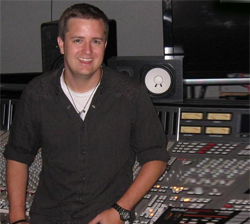Andrew Dawson is a Grammy-Award winning engineer and producer. A fast rising-star on the scene, his credits include Kanye West, Common, T.I., Jay-Z, Destiny’s Child, Lil Wayne, Drake, Rick Ross, Erykah Badu & more.
He’s been the primary tracking & mix engineer for the last 4 Kanye West albums, including the latest, “My Beautiful Dark Twisted Fantasy.”
Andrew kindly took time out of his busy schedule to speak with me – Engineer to Engineer – discussing his history, his approach, and the future… Enjoy!
You’re living in LA now, but you are originally from Minnesota.
I’ve been living in LA for 3 years now. I went to Berklee in Boston, and lived in New York for 6 years working at Sony, Hit Factory, Quad, and Legacy. All of those spots started closing down, and it’s too freaking expensive to live there. I was thinking that I was going to move to LA more and more.
I understand the feeling, but it’s intimidating to make that kind of move. Did you have any leads?
I had been freelancing since I was like 23. The numbers just started making sense to go freelance. When I moved out here, I never really had problems getting work. Once I made the decision to move, I was out here a week later working with Common! LA’s awesome.
What I’ve been able to do in LA – what a lot of the mixers are doing now – is have my own facility on Sunset, two blocks away from Hollywood Highland. It’s not like I’m going to track orchestras in there, but it works. It’s about 1100 square feet, has a nice lounge etc… that would be like ten stacks a month in NY. I’m in the heart of it all. People are cool with stopping by my studio to work, and I don’t have to drop 2 grand a day on a big room. It allows me to mix at a comfortable pace. With my clients, I charge my fee and a facility fee. The facility fee simply covers my overhead costs.
Let’s talk about your professional path. What was the route?
I’ve been working at studios and doing live sound since high school. I was doing outdoor concert festivals – 500 to 600 people a day. I don’t know why anyone would hire me at 16, but I did FOH – large shows with 5 monitor mixes and such. I worked in a studio as a coffee boy even before attending Berklee. I did a lot of live sound for summer tours. While attending Berklee, I worked for Lexicon. When I left, I interviewed at the Hit Factory and Sony Music. Because of the live sound stuff and the Lexicon gig, I was like, I don’t want to be an intern – I kind of want to start as an assistant. The studio manager said if I can get down here and learn the rooms, I’d have a chance.
I literally moved from Boston to NY in a week, took the job at Sony Music Studios and in 2 or 3 months I was assisting. At that place they had 7 mixing rooms, 4 mastering rooms, sound stage, tie lines between everything, 2-inch tape reels, Pro Tools. If I couldn’t handle that, I was toast. It was probably the hardest place to work as an assistant engineer. It was awesome being able to work there though. I never became anybody’s regular assistant, but I worked with guys like Bob Power and Tony Maserati. I remember learning a lot from Dexter Simmons too.



















